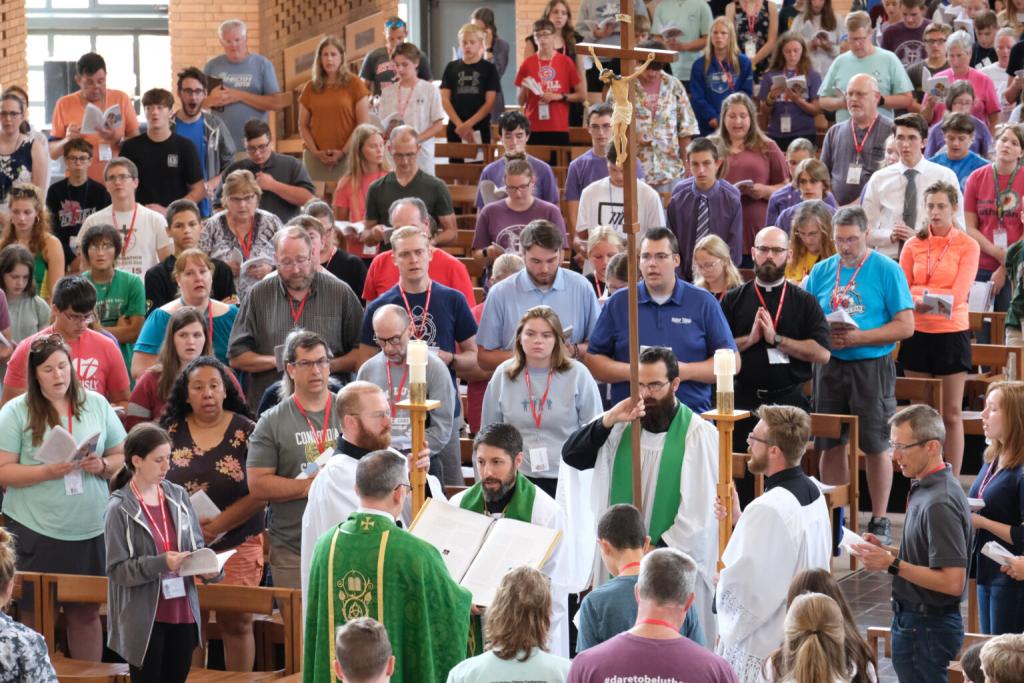Yesterday we discussed statistics about converts to the Lutheran Church Missouri Synod, based on demographer Lyman Stone’s Lutheran Religious Life Survey. Today we’ll look at what that study found as to the reasons that people come into the Lutheran Church Missouri Synod from the outside, whether as non-believers converting to Christianity or Christians from other traditions converting to Lutheranism (like me).
Stone gave the converts a list of reasons, allowing them to check more than one. Here are the reasons, in order (based on a graph in the study , the second report, so the numbers may not be precise):
- Wanted Something Fresh (just over 70%)
- Found Sense of History (just under 70%)
- Found Community (just under 65%)
- Liked Style, Music, Aesthetic (just over 45%)
- Mentor Influence (around 45%)
- Convinced Prior Faith False (just under 40%)
- Romantic Relationship (a little more under 40%)
- Invited by a Friend (just under 35%)
- LCMS Political Stances (just over 30%)
- Supernatural Experience (just over 10%)
- Felt Judged in Prior Faith (10%)
“Romantic Relationship” would be those taking Adult Confirmation because they were getting married and agreed to join the future spouse’s church. (That is a perfectly valid reason: Some of the most devoted Lutherans I know came into it when they got married.) “LCMS Political Stances”? I didn’t think the LCMS had any, which was perhaps what they found so attractive about it. Or maybe they were thinking of moral issues that have become political, appreciating the strong pro-life position of the LCMS. “Supernatural Experience”? Well, we Lutherans are not “enthusiasts.” “Felt Judged in Prior Faith”? This would be a reference to the legalism of so many churches.
Stone then sorted out the reasons given according to the type of congregation the converts joined. He says of “Missional” churches with their contemporary worship:
Almost 80% of converts who attend contemporary services report a romantic relationship around the time of conversion. Over 90% report a strong sense of community. Indeed, converts in contemporary settings are very likely to agree that all community-related factors greatly influenced their experience. Additionally, about 80% of converts in contemporary services reported liking the style, music, or aesthetic as a factor in conversion. On the other hand, just 10% of these converts said that a conviction that their prior beliefs were false was a key factor in their conversion. To reiterate, these converts in contemporary services do report high agreement rates with statements of Lutheran belief today; they are simply reporting that this was not a decisive factor in their conversion.
As for the “Confessional” congregations,
Converts in traditional services are far more likely to report that they were convinced that their prior faith was false. This reason was still just 45% of converts in these services, but no single reason captured much more than 60% of converts in traditional services, so 45% is a relatively high rate in comparison. Among converts in traditional services, then, doxic conversion often precedes social conversion. These converts may have first encountered the LCMS via Lutheran publications, podcasts, or theological writings, and so often become convinced of LCMS doctrines before encountering LCMS congregations, or very shortly thereafter.
An encouraging finding is that both converts who go to “Missional” congregations and those who go to “Confessional” congregations, no matter why they joined initially, score highly on belief in Lutheran doctrine. And converts to both “Missional” and “Confessional” congregations show strong appreciation for the sense of community that they have found in their new churches.
Two more findings jump out.
First, Lutheran schools matter. Stone found that a large percentage of converts of every sort were influenced by Lutheran schools:
Converts from non-Christian backgrounds are about 40 times as likely to have been in LCMS schools than the average American, converts from other Christian backgrounds are about 80 times as likely, and converts from other Lutheran backgrounds are about 180 times as likely.
Not only that,
LCMS children enrolled in LCMS schools are likelier to remain LCMS as adults than LCMS children not enrolled in LCMS schools. Likewise, that converts into the LCMS are astronomically likelier to have attended LCMS schools than might be expected from random chance implies that LCMS schools are a key element in personal conversion histories.
Second, young LCMS members are highly, highly sacramental. More so than old Lutherans: “Younger LCMS members espouse much greater emphasis on the visible means of grace than older LCMS members, a trait shared in common with ‘Confessional and Traditional’ LCMS members.”
And this has profound implications for the church’s future [my bolds]:
This generational change is consistent with the conversion and growth data cited above: virtually all available evidence points to the notion that, in 30 years, the LCMS will be a more liturgically traditional church than it is today, with doctrinal positions more differentiated from the Protestant mainstream than it has today. To the extent that doctrinal differentiation is associated with growth and conversion, this statement could point to the possibility that, by the latter 21st century, the LCMS could experience an appreciable improvement in net conversion rates, though this is more speculation than forecast.
Photo: Higher Things LCMS youth conference via Higher Things website.












